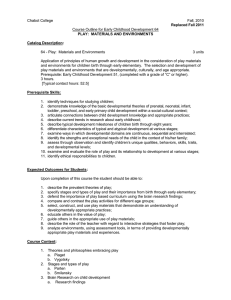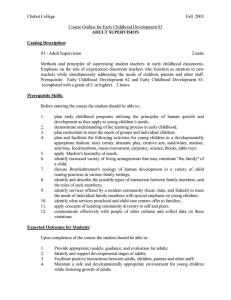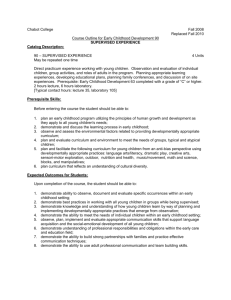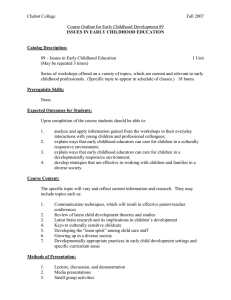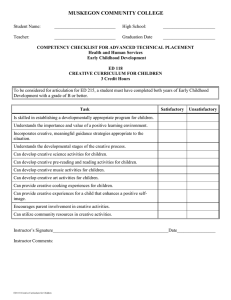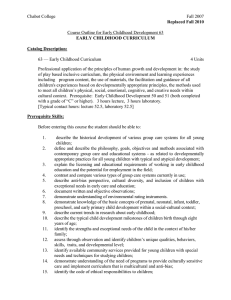Chabot College Fall, 2010 Course Outline for Early Childhood Development 90
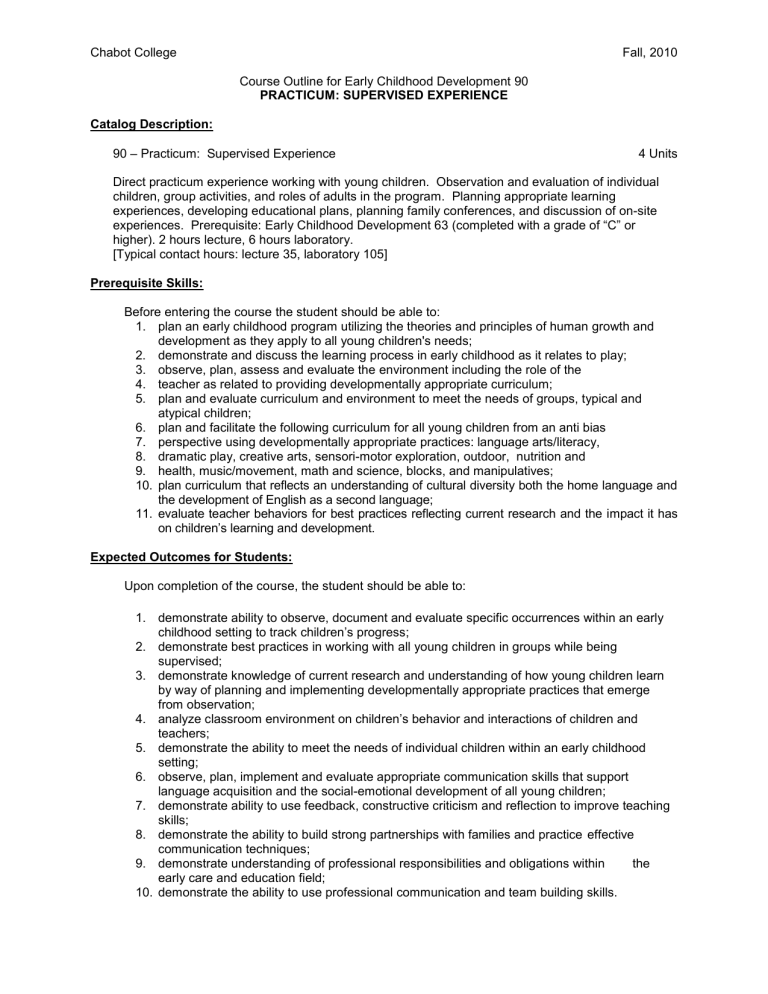
Chabot College Fall, 2010
Course Outline for Early Childhood Development 90
PRACTICUM: SUPERVISED EXPERIENCE
Catalog Description:
90 – Practicum: Supervised Experience 4 Units
Direct practicum experience working with young children. Observation and evaluation of individual children, group activities, and roles of adults in the program. Planning appropriate learning experiences, developing educational plans, planning family conferences, and discussion of on-site experiences. Prerequisite: Early Childhood Development 63 (completed with a grade of “C” or higher). 2 hours lecture, 6 hours laboratory.
[Typical contact hours: lecture 35, laboratory 105]
Prerequisite Skills:
Before entering the course the student should be able to:
1. plan an early childhood program utilizing the theories and principles of human growth and development as they apply to all young children's needs;
2. demonstrate and discuss the learning process in early childhood as it relates to play;
3. observe, plan, assess and evaluate the environment including the role of the
4. teacher as related to providing developmentally appropriate curriculum;
5. plan and evaluate curriculum and environment to meet the needs of groups, typical and atypical children;
6. plan and facilitate the following curriculum for all young children from an anti bias
7. perspective using developmentally appropriate practices: language arts/literacy,
8. dramatic play, creative arts, sensori-motor exploration, outdoor, nutrition and
9. health, music/movement, math and science, blocks, and manipulatives;
10. plan curriculum that reflects an understanding of cultural diversity both the home language and the development of English as a second language;
11. evaluate teacher behaviors for best practices reflecting current research and the impact it has on children’s learning and development.
Expected Outcomes for Students:
Upon completion of the course, the student should be able to:
1. demonstrate ability to observe, document and evaluate specific occurrences within an early childhood setting to track children’s progress;
2. demonstrate best practices in working with all young children in groups while being supervised;
3. demonstrate knowledge of current research and understanding of how young children learn by way of planning and implementing developmentally appropriate practices that emerge from observation;
4. analyze classroom environment on child ren’s behavior and interactions of children and teachers;
5. demonstrate the ability to meet the needs of individual children within an early childhood setting;
6. observe, plan, implement and evaluate appropriate communication skills that support language acquisition and the social-emotional development of all young children;
7. demonstrate ability to use feedback, constructive criticism and reflection to improve teaching skills;
8. demonstrate the ability to build strong partnerships with families and practice effective communication techniques;
9. demonstrate understanding of professional responsibilities and obligations within the early care and education field;
10. demonstrate the ability to use professional communication and team building skills.
Chabot College
Course Outline for Early Childhood Development 90, page 2
Fall, 2010
Lecture Content:
1. Development and implementation of developmentally appropriate experiences for young children a. Planning emergent curriculum based on observation and individual needs b. Using observation and authentic assessment in the planning of developmentally appropriate experiences c. Planning and implementing the state guidelines in a play based environment d. Curriculum Cycle-observation, planning, implementation, evaluation, and documentation e. Selecting materials and experiences based on the developmental needs of individual children and the group f. Supporting individual children across all developmental domains by adapting curriculum and materials as needed
2. Teacher child interactions a. Building relationships with children within a culturally sensitive context b. Developing and expanding language skills in children in both English and primary language c. Fostering critical thinking and problem solving skills with children d. Adults ’ role in modeling for young children
3. Guidance and classroom management a. I mpact of environment on child’s behavior b. Respectful teacher/child communication c. Positive guidance strategies and techniques d. Conflict resolution and problem solving to meet the individual needs of children e. Unique needs of children with special needs and challenging behaviors f. Dual focus: balancing individual and group needs
Laboratory Content:
1. Development of the Early Childhood Teacher a. Developmental stages of the teacher b. Self reflection, attitude and awareness c. Role of the teacher in early care and education settings d. Receiving and using feedback and constructive criticism e. Reflective practices to improve teaching skills f. Portfolio documentation g. On-going professional growth and development
2. Partnerships with families a. Developing effective communication skills within a cultural context b. Recognizing the family as the primary caregiver c. Supporting families with a child who has special needs d. Family conferences
3. Professionalism and communication a. Adult communication techniques b. Effective team building skills c. Professional advocacy and obligations d. National Association for the Education of Young Children (NAEYC) Code of Ethical conduct
Methods of Presentation:
1. Lectures, discussion and activities
2. Demonstration and implementation of curriculum
3. Small groups
4. Role play
5. Audio-visual materials
Chabot College
Course Outline for Early Childhood Development 90, page 3
Fall, 2010
Assignments and Methods of Evaluating Student Progress:
1. Typical Assignments
2. Observe in a variety of classrooms and write a brief description of each classroom, complete comparison and contrast each environment based on age and development of children.
3. Plan and implement a minimum of 6 activities with children in different curriculum areas.
4. Teacher observation: Focus on the teacher and classroom functioning. Focus will be on the teacher interactions with children and teacher to teacher/adult interactions. Evaluate teacher’s philosophy as it relates to the needs of the children and evidence of planning for the individual as well as the group.
5. Reflective journal writing of practicum experience.
6. Methods of Evaluating Student Progress a. Participation and attendance b. Written assignments c. Midterm examination d. Ongoing lab observation and evaluation e. Journal writing f. Final examination
Textbook(s):
Student Teaching, Early Childhood Practicum Guide , Jeanne Machado and Helen Meyer
Botnarescue, 6th edition, Delmar Publishers, New York, 2008.
Developmentally Appropriate Practice in Early Childhood Programs, Sue Bredekamp, and
Copple, Editors, 3rd edition, National Association for Preschool Education, Washington, D.C.,
2009.
Special Student Materials:
None
ECD 90, revised 9/09: cs
